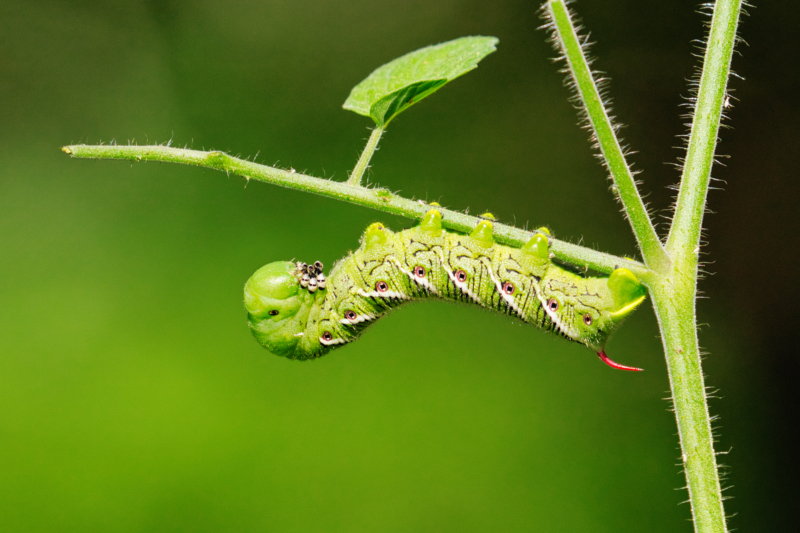In the lush landscapes of my Arkansas vegetable garden, back in September 2016, I had a remarkable encounter with a fascinating insect. While tending to my tomato plants, I noticed subtle signs of leaf damage that hinted at the presence of a voracious caterpillar. My curiosity led me to a close examination, revealing the miscreant – a sizable, green Tobacco Hornworm feasting on the foliage.

The Intriguing Tobacco Hornworm
This particular hornworm possessed a distinctive feature – a conspicuous red horn protruding from its rear end, a characteristic trait of the Tobacco Hornworm species. It measured approximately four inches in length and sported white diagonal stripes along its sides. As a wildlife photographer, moments like these, where nature unfolds in my own backyard, never fail to excite me. Without hesitation, I grabbed my camera equipped with a long lens, ready to capture this captivating caterpillar.
Differentiating from the Tomato Hornworm
The red horn serves as a key differentiator between the Tobacco Hornworm and its close relative, the Tomato Hornworm, which boasts dark horns. The green hue of the Tobacco Hornworm provides it with effective camouflage as it indulges in its leafy banquet, often escaping notice amidst its host plants.
Coexistence with Garden Pests
As someone who understands the havoc hornworms can wreak on a garden, I am well acquainted with their voracious appetite. However, I can’t bring myself to eliminate them, recognizing that they are simply following their instinct to survive and complete their life cycle. As long as their numbers remain manageable, I don’t mind sharing a portion of my garden’s bounty. After capturing some stunning photographs, I gently relocated this particular caterpillar to another part of my yard.
The Transformation of a Tobacco Hornworm
Now, you might be wondering, “What does a Tobacco Hornworm turn into?”
Tobacco Hornworms, like other hornworms, go through a remarkable transformation. They pupate and eventually emerge as large, impressive moths known as the Tobacco Hornworm Moth (Carolina Sphinx Moth). These moths are often mistaken for hummingbirds due to their rapid wing-beats and hovering flight patterns. They play a crucial role in pollination as they feed on nectar from various flowers, making them valuable contributors to the ecosystem.
Image Details
- Date: September 12, 2016
- Time: 9:05:34 AM
- Camera: Canon EOS 7D Mark II
- Lens: Canon EF 100 – 400 mm f/4.5-5.6L IS II
- ISO: 320
- Aperture: 7.1
- Shutter Speed: 1/1000
- Exposure Compensation: 0.0
This close encounter with the Tobacco Hornworm serves as a testament to the wonders of nature that can be discovered right in our own backyards. While garden pests can be a nuisance, they also play a vital role in the intricate web of life.
Steve Creek, Wildlife Photographer
Note: A few days later I spotted another Hornworm, but this one had cocoons attached to it: Braconid Wasp Cocoons On A Hornworm
